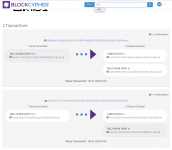Hey - I wasn't aware of this story before, and I love this sort of investigation, so I did a little digging. Here's my understanding:
- Block 4137 generated 500.058 DASH block reward in its coinbase transaction - 500 DASH plus fees. This is normal. Since there were no masternodes then, the entire block reward went to the miner.
- One of the four other transactions recorded in this block was a transfer of 186214.713 DASH from one address to another, with no change address (i.e. whole balance was transferred). Yes, a relatively large amount, but not worth much back then. The other transactions in this block are around 40 DASH and not interesting to us.
- Where did this relatively large amount of Dash come from? There are 366 UTXOs used as inputs in the transaction, all of them from a single address: XnFYAdnaYsY9rAJqsnoQcyiVPtyB3PUvn5
- So let's examine the source of these 366 inputs. For some reason the Insight block explorer I was using above fails at this point, but explorer.dash.org can help us!
- This page shows how the 186214.713 DASH was accumulated over time - as far as I can tell, all of it is from block rewards that were (automatically?) transferred to the XnFY address once it had matured (i.e. became transferable).
- The first transfer to XnFY is for 500 DASH and occurs in block 3040 as a normal transfer. This 500 Dash was mined in block 2804, so I thought that is when we can assume this user began mining. This block was mined at 2014-01-19 08:39:58, about 4 hours and 45 minutes after launch. Early, but by no means the first miner.
- A bit more investigation actually shows some value moving to XnFY from blocks that were mined as early as block 2600, which can be traced to the XnFY address after 1-2 transactions as well.
- Block 3061 contains a number of these transfers worth exactly 5000 DASH. One of them includes coins generated in block 2490, which was as far back as I was able to find with my random point-and-click approach. There is probably a more scientific way of doing this at this point...
Just out of interest, I started looking at even earlier block around blockheight 200-600. That quickly leads to other "large" transactions like the one we started with in block 4137. For example, some of the earliest mining rewards from e.g. block 273 are spent directly in
this transaction worth 157500 in
block 13740. Another appears in
block 13751.
Analysis
There is a difference here between the transfers in block 4137 (let's call this Miner A, the one you were looking at) and block 13740 (Miner B).
- Miner A moves the mining rewards to a single address (XnFY) before spending, which makes it look like a single input in the block 4137 transaction in some block explorers, although 366 UTXOs from this address are actually being spent.
- Miner B spends the mining rewards directly from the addresses they were mined to, so the transaction in block 13740 contains a lot of UTXOs from different addresses as inputs.
You can see the block reward for the inputs used in Miner A's transaction varying between 500, 100 and 277 over this time as the difficulty changes when miners start/stop hashing. This should not happen, and Evan was probably trying to adjust the difficulty algorithm during this time to get a consistent block time and reward as hash power changes. He
states there was no block explorer in these early days, so figuring out what was going on must have been a nightmare - the only way would have been to look at the value accumulating in a wallet and transferring it around. This incorrect variability in block reward and time is what resulted in the development of
Dark Gravity Wave, a method of adjusting difficulty each block instead of every 576 blocks.
Speculation
The transaction you spotted and others I have dug up here are probably one of the other early miners consolidating block rewards in a single place for better management or spending/trading/distribution/hodling. While the coins were being generated at an extremely high rate, I can't see any evidence of malicious intent to prevent others mining - it's possible that the blocks of transactions I uncovered are in fact two different miners, judging by the different patterns they exhibited in collecting the block rewards together and moving the value around.
Conclusion
Evan says the block reward problem was fixed around 4500, and
block 4502 indeed shows a more sensible reward of 56 DASH. You can see people discussing the incorrect block reward and difficulty adjustment and trying to compile working code and miners
here.

